21 March, 2019
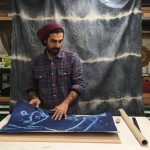
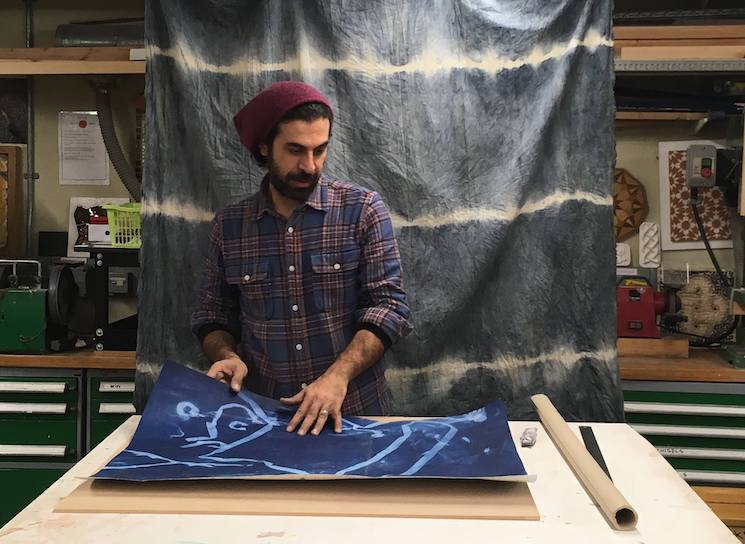
Shorsh Saleh, a Kurdish mixed-media artist, carpet designer and weaver, is taking up residency in the art studio in our Room to Breathe exhibition in April 2019.
Having travelled to the UK as a refugee 17 years ago, Saleh deals with the subjects of migration, borders and identity through his work – with a particular focus on the Kurdish people, who have been stateless and subject to persecution for the past 100 years.
“As someone who was born and raised in a war zone, art has always been a form of therapy, a magical tool to escape from suffering and trauma since I was a child. As a Kurdish artist my works relate to my experience as a stateless person, becoming a refugee and witnessing the deaths of hundreds of people. Art kept my soul alive during the process of leaving my homeland, the two years of travelling across borders illegally and the eight years of waiting for asylum in the UK,” Saleh explains.
Saleh includes the traditional techniques of miniature painting in a contemporary context, using handmade natural pigments, dyes and papers. Saleh is also an experienced Persian carpet maker and many of his works are inspired by the symbolic motifs used in traditional carpets, combined with contemporary imagery.
His current series of works are based on the subject of migrant journeys by sea and the imaginary notion of flying carpets being used to cross borders.
Saleh studied MA Traditional Arts at The Prince’s School of Traditional Arts in London, where he has been teaching carpet weaving since 2015. He has also been teaching at the Museum of Islamic Art in Doha since 2017.
Saleh has exhibited both nationally and internationally. His works are held in the Royal Collection Trust, the British Museum, the Bagri Foundation and The Islamic Art Museum, Malaysia.
During Saleh’s open studio, participants will have access to geometric designs and biomorphic carpet motifs to copy and colour. These will be exhibited in his studio alongside his artwork throughout his residency, which runs from 4 April–28 April 2019.
Find out more about Shorsh Saleh by visiting his website and following him on Instagram.
Artist-led workshops
Flying-carpet weaving workshop, Sunday 14 April 2019 | 12pm–5pm | £20 (advance booking essential – click here to book)
Free drop-in sessions
Shorsh will be in his studio in our Room to Breathe exhibition between 3pm and 5pm every Saturday during his residency, when you can stop by to chat with him, and design your own flying carpet.
Residency details
Dates: 4 April–28 April 2019
Address: Migration Museum at The Workshop, 26 Lambeth High Street, London SE1 7AG
Opening hours: Thursday 12pm–8pm, Friday–Sunday 12pm–6pm
Free meet-the-artist sessions: Every Saturday from 6 April until 27 April 2019 | 3pm–5pm
About the art studio in Room to Breathe
The art studio inside our Room to Breathe exhibition is a space curated by visual artist and educator Dima Karout to explore the role of art and creativity in helping people settle into new lives in Britain, and to offer educational art experiences for visitors. Each month, the studio will host a different migrant artist to share their work and process.
View the full schedule of artists in residence and find out more about Room to Breathe
14 March, 2019

Ceyda Oskay is the new artist in residence in our current exhibition, Room to Breathe. As with previous artists, we asked Ceyda and the curator in residence of the art studio, Dima Karout, a series of questions and answers to find out more about Ceyda’s artistic practice.
Ceyda uses textiles to explore symbolic themes around migration experiences, inviting us to engage with more abstract concepts and reminding us that individual migration projects are shaped by more than the structural dimensions of poverty or conflict. Her interest revolves around the exploration of dreams, utopias, dystopias in migration experiences, and her artistic practice features a unique use of textiles, imprints and interactive spaces.
Ceyda is also offering visitors the chance to participate in workshops where they can learn about, and contribute to the making of, a wide range of objects and artworks.
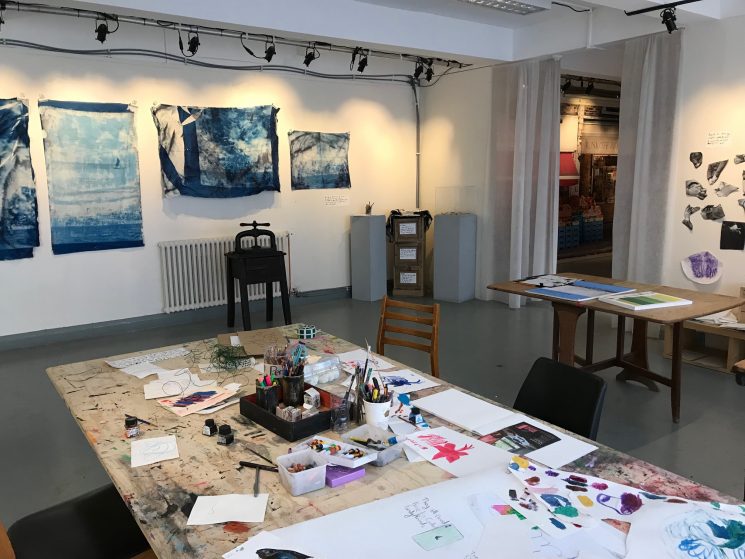
Ceyda Oskay’s studio in “Room to Breathe” © Migration Museum
Assunta Nicolini (AN): Textiles are the dominant medium in your artistic practice, especially your work currently on display at the Migration Museum – why textiles in particular?
Ceyda Oskay (CO): I’ve always been interested in textiles. My mother and grandmother taught me different textile techniques in Turkey and I remember making clothes for my Barbie dolls. Growing up in Saudi Arabia, part of the Silk Road, I remember going to fabric markets with my mother, where there would be textiles from all around the world. I loved textiles for their diversity and expressiveness. It always felt very natural for me to use textiles to express myself or my ideas with.
Additionally, socially, textiles have been very important in world history from the trade in natural dyes and the social status of Tyrian purple for royalty, the trade in indigo and its transformative effect on farms in India, to textile weaving and the British industrial revolution.
Having moved around a lot, I have always been interested in the versatility of textiles, and the way they can so easily be transported. I am also interested in, and I’m co-writing a chapter on, Sadu weaving – which is the nomadic weaving used to make tents and bags in the Arabian peninsula and beyond. There, the textiles form a home.
Additionally, textiles themselves are transformative – they can be changed into another item just by altering the way they are sewn and put together. They are easy to experiment with and I like experimentation in my work. I like the versatility and expression textiles offer, and their universality.
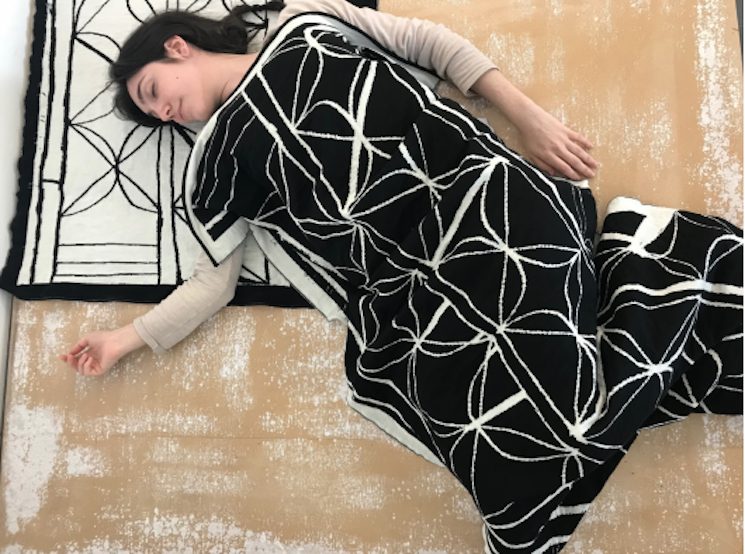
A doodle blanket, 2018 © Ceyda Oskay
AN: To what extent has your lived experience as a migrant and a practitioner working with migrants and refugees around the world shaped your artistic and conceptual work? And how did you develop your interest in ideas of utopia, dystopia and dream in migration contexts?
CO: Interesting question – because for many years as a practitioner, I couldn’t make art in the traditional sense. I started to move away from art as an object, or even installation, and towards art as an experience.
I was interested in migration and war as memory, having done humanitarian work in relation to Syria and Iraq – but, rather than preserving this memory in an object, I’m more interested in creating new and diverse experiences between people that transform them and create the hope of something better.
I’m really interested in the work of the Artist Placement Group (APG), which embeds artists in institutions – and in work like Francis Alÿs’s paint can, where he pours a thin line of paint along an international border.
In terms of dreams, I’m currently trying to make person-specific sleepwear and sleeping bags: the blue Cyanotypes were going to be transformed into sleep clothes, and I’m collecting images from friends that are of a place that inspires or calms them . . . I’m collecting sound recordings of lullabies in different languages, and trying to put that together with creating sleeping bags. It’s a way of bringing object, travel, experience and interactivity together. I’d love it if visitors contributed lullabies, or took part in the dream-clothes somehow.
AN: Dima, as curator in residence of the art studio inside Room to Breathe, could you tell us how and why you selected Ceyda’s work and how it relates to the other upcoming artists in residence?
Dima Karout: When I was invited to curate the art studio space, the first thing I proposed was to take a democratic approach and to launch an open call allowing us to reach migrant artists based in London and working on themes related to resilience through art.
We offered residencies to Ceyda Oskay, Shorsh Saleh and Belen L Yañez, three artists with a body of work inspired by their personal journey and human connections – artists who are generous, able to share their knowledge and creative process, and willing to include visitors in a participatory practice.
I was touched by Ceyda’s unique journey: travelling between countries, then landing in London with experiences related to different communities in which she had witnessed people’s stories and connection to their surroundings, and where she had created participatory art, and undertaken humanitarian work. I sensed that Ceyda’s presence at the Museum would provide visitors with an intimate experience and an elaborate understanding of the meaning of home and belonging.
When you step into Ceyda’s studio at the Migration Museum, you are immediately immersed in fragile stories assembled with a high level of sensitivity, intimate moments that she brilliantly re-created to communicate fragments of her journey. Ceyda created a dreamlike space for all of us to experience on our own: textile art filling the walls, a shell series presented in a corner, an open invitation to all visitors to share their lullabies, dreams and places. Through this experience visitors can engage in a wider conversation around the illusional borders that some of us have never visited and shake our perception about the meaning of a place.
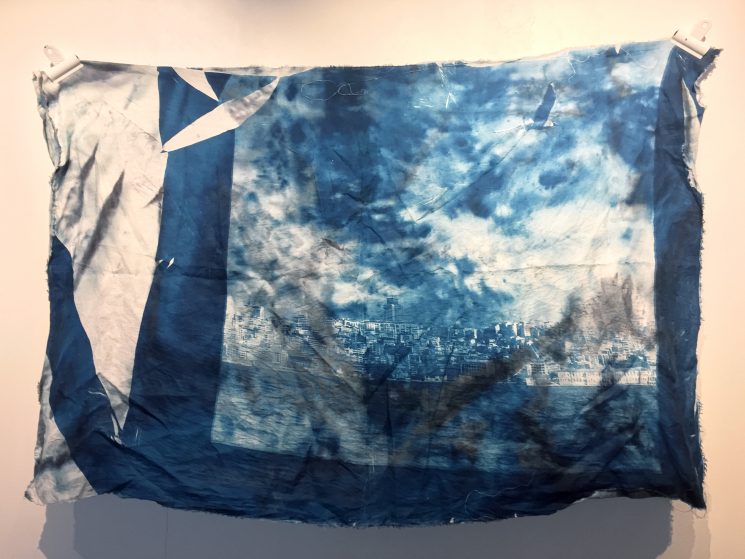
“The Bosphorous between Asia and Europe – The seagull has migrated from Peru – The textiles look dream-like, reminding us of dreams and places we go to in our dreams, and of utopias and dystopias” © Ceyda Oskay
A wall in Ceyda’s studio combines photos from the Bosphorus printed on fabrics using Cyanotype print technique. With its blue shades, the work brought the sky and the sea into my thoughts. And one of the photos in particular brought me to my own journey. I found myself glimpsing out of Ceyda’s window while juxtaposing my own hometown over her landscape – I floated to Damascus creating an assemblage of its building as if I were standing there in the comfort of my distant home.
Ceyda’s work is powerful. It took me and museum visitors on a textural and pictorial journey full of fragility, humanity, dreams and hope. And I am happy that with the museum team and visitors we were given the chance to discover and reflect on this influential work.
AN: Belen and Shorsh, as upcoming artists in residence, could you tell us how you relate to specific work by Ceyda?
Belen L Yañez: Ceyda’s piece “Hands on Subway/London Underground” instantly grabbed my attention. I am currently working on a piece called “Encounters”, in which I invite participants to establish a dialogue with each other using their hands to foster an empathic connection with people who may not share the same cultural background nor have the same physical appearance. Ceyda’s piece is composed of several copies of photos of the hands of immigrants and people travelling within London. Stopping for a minute and observing those hands is enough to allow you to read their meaning. It was wonderful to breathe the diversity of travellers who inhabit the London Underground, to imagine their stories and somehow to connect with them for a few minutes.

Hands on subway/London Underground of immigrants and people travelling within London © Ceyda Oskay
Shorsh Saleh: Ceyda printed oyster shells that she found on the Isle of Sheppey in the UK. The shells have images of military pillboxes falling over that look like homes; other shells have images of boats on them.
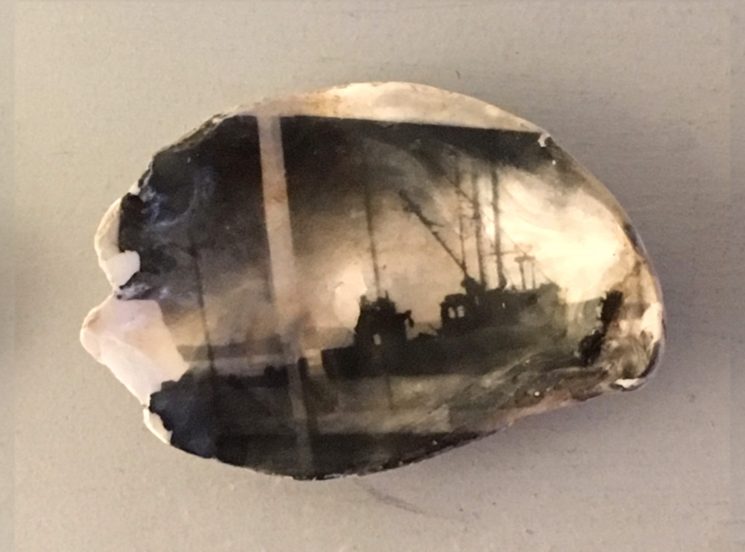
© Ceyda Oskay
As a migrant myself, Ceyda’s work spoke to me about journeys taken across seas in search of a new homeland. I felt a connection to the shell series she is presenting in her art studio. The ethereal imagery of boats and seascapes symbolises to me the difficulty of journeys, all contained within a broken shell that had once been a safe home.
Ceyda Oskay is in Room to Breathe until Sunday 31 March and will be holding a pillow-making workshop on Saturday 23 March and a family T-shirt making workshop on Saturday 30 March. Tickets for both these workshops are available through Eventbrite. Assunta Nicolini, gallery supervisor, is curating further blogs about the next artists who are due to have a residency in the gallery (details are available on our exhibition page).
21 February, 2019
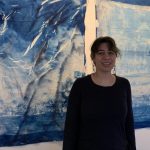
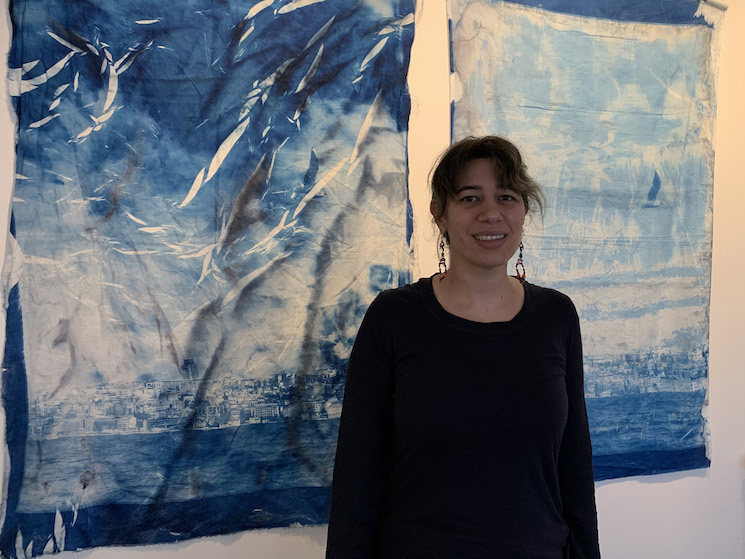
We are delighted to welcome Ceyda Oskay as our next artist in residence as part of our Room to Breathe exhibition. Ceyda will be taking up residency from 28 February until 31 March 2019.
Ceyda is a multimedia artist who frequently explores notions of place and human relationships in her work. Her work ranges from social practice and socially engaged work, to experimental photography, ceramics, sculpture and installation, fibre and textiles, to painting.
Ceyda studied at the University of Chicago, METU University, School of the Art Institute of Chicago, and is currently at the Royal College of Art. She worked on humanitarian and development work for the United Nations for Syria, Turkey, Iraq, Eastern Europe and Central Asia, for over ten years and is currently a consultant in the field. She has visited 24 countries, and studied, worked and exhibited in places including Iceland, Greece, Kuwait, Turkey, USA, UAE and the UK, most recently at the Liverpool Independents Biennial. She has also co-authored an upcoming publication on nomadic Sadu weaving in the Arabian Peninsula.
“Migration is a major theme in my artwork as I have moved about once a year for a very long time. Since coming to London last year, I’ve moved six times,” Ceyda writes in the text welcoming visitors to her art studio in Room to Breathe.
“Art-making for me is about expressing ideas and feelings, about exploring materials, about places and relationships. The materials I pick for each piece vary depending upon the particularities of each artwork. Much of my work is done with fabric, because of its nomadic, transportable nature. Other work is made from stronger material, but is small – again easily transportable. I also enjoy making crafts and utilitarian items in different ways, sometimes clothes and fashion – and this too is influenced by migration.
As I have done humanitarian work in the war contexts of , countries including Syria and, Iraq, among other places, Kuwait, Eastern Europe and Central Asia, my artwork is often influenced by war and conflict. This artwork is in the form of prints – like the imprints of a war. Some of my other artwork is about human interaction and social engagement, and is more about hope and forming new relationships.
My work has an experimental component: I often don’t know what it will be until it is complete.”
As well as hosting weekly drop-in sessions in her art studio during her residency, Ceyda will be running a programme of public workshops, ranging from pillow and t-shirt making to discussions on music, places, sleep and dreams – more details on all of which can be found below.
Artist-led workshops
Pillow-making workshop, Saturday 23 March 2019 | 2pm–5.30pm | £16 (advance booking essential – click here to book)
Family T-shirt making workshop, Saturday 30 March 2019 | 2pm–4pm | £10 (one adult and one child – click here to book)
Free drop-in sessions
Every Sunday between 3pm and 4pm during her residency, Ceyda will be in her studio in our Room to Breathe exhibition. You can stop by to chat with her, and make wire-prints of home on a traditional press. At the moment, she is working on making sleepwear from images her friends give her of places for a piece about dreams, places, and sleepwear. She would love to talk to you about places that provide calm and inspiration to you, places of home, utopias – and dreams.
During Ceyda’s open studio, participants will have access to paper, wire and a printmaking press where they can make wire line drawings of what reminds them of home, and create embossments (raised prints) from them. These will be exhibited in her studio alongside her artwork, during the time of her residency.
Drop-in sessions: Every Sunday from 3 March until 31 March 2019 | 3pm–4pm
Residency details
Dates: 28 February–31 March 2019
Address: Migration Museum at The Workshop, 26 Lambeth High Street, London SE1 7AG
Opening hours: Thursday 12pm–8pm, Friday–Sunday 12pm–6pm
Find out more about Ceyda Oskay (website: ceydaoskay.com, Instagram: ceydaoskayart)
About the art studio in Room to Breathe
The art studio inside our Room to Breathe exhibition is a space curated by visual artist and educator Dima Karout to explore the role of art and creativity in helping people settle into new lives in Britain, and to offer educational art experiences for visitors. Each month, the studio will host a different migrant artist to share their work and process.
View the full schedule of artists in residence and find out more about Room to Breathe











